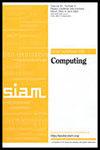Approximation Algorithms for LCS and LIS with Truly Improved Running Times
IF 1.6
3区 计算机科学
Q3 COMPUTER SCIENCE, THEORY & METHODS
引用次数: 0
Abstract
SIAM Journal on Computing, Ahead of Print.Abstract. Longest common subsequence (LCS) is a classic and central problem in combinatorial optimization. While LCS admits a quadratic time solution, recent evidence suggests that solving the problem may be impossible in truly subquadratic time. A special case of LCS wherein each character appears at most once in every string is equivalent to the longest increasing subsequence (LIS) problem which can be solved in quasilinear time. In this work, we present novel algorithms for approximating LCS in truly subquadratic time and LIS in truly sublinear time. Our approximation factors depend on the ratio of the optimal solution size to the input size. We denote this ratio by [math] and obtain the following results for LCS and LIS without any prior knowledge of [math]: a truly subquadratic time algorithm for LCS with approximation factor [math] and a truly sublinear time algorithm for LIS with approximation factor [math]. The triangle inequality was recently used by M. Boroujeni, S. Ehsani, M. Ghodsi, M. HajiAghayi, and S. Seddingham [Proceedings of the 29th Annual ACM-SIAM Symposium on Discrete Algorithms, 2018, pp. 1170–1189] and D. Chakraborty, D. Das, E. Goldenberg, M. Koucky, and M. Saks [Proceedings of the 59th Annual IEEE Symposium on Foundations of Computer Science, 2018, pp. 979–990] to present new approximation algorithms for edit distance. Our techniques for LCS extend the notion of the triangle inequality to nonmetric settings.
真正改善运行时间的LCS和LIS的近似算法
SIAM计算机杂志,出版前。摘要。最长公共子序列(LCS)是组合优化中的一个经典和核心问题。虽然LCS承认一个二次时间解,但最近的证据表明,在真正的次二次时间内解决问题可能是不可能的。LCS中每个字符在每个字符串中最多出现一次的一种特殊情况相当于最长递增子序列(LIS)问题,该问题可以在拟线性时间内解决。在这项工作中,我们提出了在真正次二次时间内逼近LCS和在真正次线性时间内逼近LCS的新算法。我们的近似因子取决于最优解大小与输入大小的比值。我们用[math]表示这个比值,在不事先知道[math]的情况下,得到LCS和LIS的以下结果:一个具有近似因子[math]的LCS真正的次二次时间算法和一个具有近似因子[math]的LIS真正的次线性时间算法。最近,M. Boroujeni, S. Ehsani, M. Ghodsi, M. HajiAghayi和S. Seddingham[第29届ACM-SIAM离散算法研讨会论文集,2018,第1170-1189页]和D. Chakraborty, D. Das, E. Goldenberg, M. Koucky和M. Saks[第59届IEEE计算机科学基础研讨会论文集,2018,第979-990页]使用三角形不等式来提出新的编辑距离近似算法。我们的LCS技术将三角不等式的概念扩展到非度量设置。
本文章由计算机程序翻译,如有差异,请以英文原文为准。
求助全文
约1分钟内获得全文
求助全文
来源期刊

SIAM Journal on Computing
工程技术-计算机:理论方法
CiteScore
4.60
自引率
0.00%
发文量
68
审稿时长
6-12 weeks
期刊介绍:
The SIAM Journal on Computing aims to provide coverage of the most significant work going on in the mathematical and formal aspects of computer science and nonnumerical computing. Submissions must be clearly written and make a significant technical contribution. Topics include but are not limited to analysis and design of algorithms, algorithmic game theory, data structures, computational complexity, computational algebra, computational aspects of combinatorics and graph theory, computational biology, computational geometry, computational robotics, the mathematical aspects of programming languages, artificial intelligence, computational learning, databases, information retrieval, cryptography, networks, distributed computing, parallel algorithms, and computer architecture.
 求助内容:
求助内容: 应助结果提醒方式:
应助结果提醒方式:


